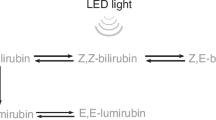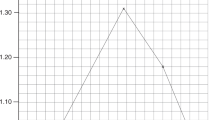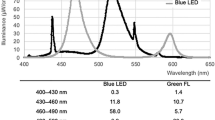Abstract
Background
Treatment of choice for hyperbilirubinemic neonates is blue light matching the absorption spectrum of bilirubin-albumin in vitro with maximum absorption at 459 nm. Blue LED light centered at 478 nm was hypothesized as being more efficient than that centered at 459 nm. This study compares the bilirubin-reducing effect of the two light qualities with equal irradiance in a randomized nonblinded clinical trial.
Methods
Inclusion criteria were healthy hyperbilirubinemic neonates with gestational age ≥33 weeks. Forty-nine neonates included in each group received phototherapy from above for 24 h. Mean irradiances were 9.2 × 1015 and 9.0 × 1015 photons/cm2/s for the 478 and 459 nm groups, respectively.
Results
Mean [95% CI] decreases in total serum bilirubin were 150 [141, 158] and 120 [111, 130] µmol/L for the 478 and 459 nm groups, respectively; mean difference was 29 [17, 42] µmol/L. Mean [95% CI] percentage decreases in bilirubin were 54.8% [52.5, 57.0] and 41.8% [39.3, 44.3]; mean difference was 12.9 [9.6, 16.3] percentage points. After adjustment this difference was 13.4 [10.2, 16.7] percentage points. All differences were highly statistically significant (P < 0.001).
Conclusion
Blue LED light centered at 478 nm had a greater bilirubin-reducing effect than that centered at 459 nm with equal irradiance quantified as photon fluence rate.
Impact
-
Blue LED light centered at 478 nm had a greater in vivo bilirubin-reducing effect than blue LED light centered at 459 nm with equal irradiance quantified as photon fluence rate in the treatment of hyperbilirubinemic late preterm or term neonates.
-
LED light centered at 478 nm might reduce the duration of phototherapy compared to LED light centered at 459 nm as the same effect can be obtained while exposing the infants to fewer photons.
-
Blue light matching the absorption spectrum of the bilirubin-albumin complex in vitro with peak absorption at 459 nm is used worldwide as it is considered to be the most effective light for phototherapy of jaundiced neonates. This study showed that blue LED light centered at 478 nm had a greater bilirubin-reducing effect than blue LED light centered at 459 nm. Therefore, blue LED light centered at 478 nm should be used instead of blue light centered at 459 nm. By this, the risk of potential side effects might be minimized, and the duration of phototherapy potentially reduced.
Similar content being viewed by others
Log in or create a free account to read this content
Gain free access to this article, as well as selected content from this journal and more on nature.com
or
References
Le Pichon, J.-B., Riordan, S. M., Watchko, J. & Shapiro, S. The neurological sequelae of neonatal hyperbilirubinemia: definitions, diagnosis and treatment of the kernicterus spectrum disorders (KSDs). Curr. Pediatr. Rev. 13, 199–209 (2017).
Slusher, T. et al. Burden of severe neonatal jaundice: a systematic review and meta-analysis. BMJ Paediatr. 1, e000105 (2017).
Donneborg, M. L., Hansen, B. M., Vandborg, P. K., Domingo, M. R. & Ebbesen, F. Extreme neonatal hyperbilirubinemia and kernicterus spectrum disorder in Denmark during the years 2000-2015. J. Perinatol. 40, 194–202 (2020).
Onishi, S. et al. Metabolism of bilirubin and its photoisomers in newborn infants during phototherapy. J. Biochem. 100, 789–795 (1986).
McDonagh, A. F. Controversies in bilirubin biochemistry and their clinical relevance. Semin. Fetal Neonatal Med. 15, 141–147 (2010).
Vreman, H. J. et al. The effect of light wavelength on in vitro bilirubin photodegradation and isomer production. Pediatr. Res. 85, 865–873 (2019).
Vandborg, P. K., Hansen, B. M., Greisen, G. & Ebbesen, F. Dose−response relationship of phototherapy for hyperbilirubinemia. Pediatrics 130, e352–e357 (2012).
Donneborg, M. L., Vandborg, P. K., Hansen, B. M., Rodrigo-Domingo, M. & Ebbesen, F. Double versus single intensive phototherapy with LEDs in treatment of neonatal hyperbilirubinemia. J. Perinatol. 38, 154–158 (2018).
Donneborg, M. L., Vandborg, P. K., Hansen, B. M., Rodrigo-Domingo, M. & Ebbesen, F. The impact of hemoglobin on the efficacy of phototherapy in hyperbilirubinemic infants. Pediatr. Res. 82, 947–951 (2017).
American Academy of Pediatrics Subcommittee on Hyperbilirubinemia. Management of hyperbilirubinemia in the newborn infant 35 weeks or more weeks of gestation. Pediatrics 114, 297–316 (2004).
Agati, G., Fusi, F., Donzelli, G. P. & Pratesi, R. Quantum yield and skin filtering effects on the formation rate of lumirubin. J. Photochem. Photobiol. B 18, 197–203 (1993).
Vreman, H. J., Wong, R. J. & Stevenson, D. K. Phototherapy: current methods and future directions. Semin. Perinatol. 28, 326–333 (2004).
Lamola, A. A., Bhutani, V. K., Wong, R. J., Stevenson, D. K. & McDonagh, A. F. The effect of hematocrit on the efficacy of phototherapy for neonatal jaundice. Pediatr. Res. 74, 54–60 (2013).
Ebbesen, F. Determination of serum bilirubin concentration during phototherapy of newborns and in vitro: results compared by direct spectrometric method and the diazo method. Clin. Biochem. 23, 695–698 (1977).
Doumas, B. T. et al. Candidate reference method for determination of total bilirubin in serum: development and validation. Clin. Chem. 31, 1779–1789 (1985).
Ebbesen, F. et al. Effect of phototherapy with turquoise vs. blue LED light of equal irradiance in jaundiced neonates. Pedriatr. Res. 79, 308–312 (2016).
Christensen, T., Kinn, G., Granli, T. & Amundsen, I. Cells, bilirubin and light: formation of bilirubin photoproducts and cellular damage at defined wavelengths. Acta Paediatr. 83, 7–12 (1994).
Roll, E. B. & Christensen, T. Formation of photoproducts and cytotoxicity of bilirubin irradiated with turquoise and blue phototherapy light. Acta Paediatr. 94, 1448–1454 (2005).
Ebbesen, F., Madsen, P., Støvring, S., Hundborg, H. & Agati, G. Therapeutic effect of turquoise versus blue light with equal irradiance in preterm infants with jaundice. Acta Paediatr. 96, 837–841 (2007).
Seidman, D. S. et al. A prospective randomized controlled study of phototherapy using blue and blue-green light-emitting devices and conventional halogen-quartz phototherapy. J. Perinatol. 23, 123–127 (2003).
Morris, B. H. et al. Aggressive vs conservative phototherapy for infants with extremely low birth weight. N. Engl. J. Med. 359, 1885–1896 (2008).
Tyson, J. E. et al. Does aggressive phototherapy increase mortality, while decreasing profound impairment among the smallest and sickest newborns? J. Perinatol. 32, 677–684 (2012).
Ebbesen, F., Hansen, T. W. R. & Maisels, M. J. Update on phototherapy in jaundiced neonates. Curr. Pediatr. Rev. 13, 76–80 (2017).
Jasprova, J. et al. Neuro-inflammatory effects of photodegrative products of bilirubin. Sci. Rep. 8, 7444 (2018).
Acknowledgements
We thank physicians and nurses for their collaboration and enthusiasm for carrying out the study, Torben Sørensen for solving technical problems, and Birgitte Christiansen for proofreading the article.
Author information
Authors and Affiliations
Contributions
F.E. conceptualized and designed the study, drafted the initial manuscript, reviewed and revised the manuscript. M.L.D. conceptualized and designed the study, collected the data, reviewed and revised the manuscript. H.J.V. designed, produced, and characterized the LED devices, designed the study, reviewed and revised the manuscript. M.R.-D. performed the statistical analyses, reviewed and revised the manuscript. A.M.M. included patients, reviewed and revised the manuscript. All authors approved the final manuscript as submitted and agree to be accountable for all aspects of the work.
Corresponding author
Ethics declarations
Competing interests
The authors declare no competing interests.
Patient consent
Informed consent, verbal and written, was obtained from the parents.
Additional information
Publisher’s note Springer Nature remains neutral with regard to jurisdictional claims in published maps and institutional affiliations.
Supplementary information
Rights and permissions
About this article
Cite this article
Ebbesen, F., Rodrigo-Domingo, M., Moeller, A.M. et al. Effect of blue LED phototherapy centered at 478 nm versus 459 nm in hyperbilirubinemic neonates: a randomized study. Pediatr Res 89, 598–603 (2021). https://doi.org/10.1038/s41390-020-0911-9
Received:
Revised:
Accepted:
Published:
Issue date:
DOI: https://doi.org/10.1038/s41390-020-0911-9
This article is cited by
-
Bilirubin isomers during LED phototherapy of hyperbilirubinemic neonates, blue–green (~478 nm) vs blue
Pediatric Research (2025)
-
Towards a pharmacokinetic approach to neonatal phototherapy
Pediatric Research (2025)
-
Efficacy of phototherapy of neonatal jaundice – light wavelength matters
Pediatric Research (2025)
-
Bilirubin: translational perspectives
Pediatric Research (2025)
-
Prototype Device for Neonatal Jaundice Phototherapy with Dynamic Physiological Monitoring Function
Journal of Shanghai Jiaotong University (Science) (2025)



